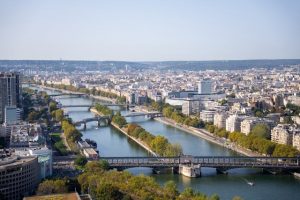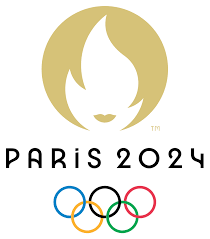| The Seine River: 2024 Games Opening Ceremony |
For the first time in the Summer Olympic Games, the Paris 2024 opening ceremony will take place outside a stadium, on the Seine River. The Seine River, one of the most iconic rivers in the world, flows gracefully through the heart of France, shaping its history, culture, and economy. The Seine River, a serene and iconic waterway, flows gracefully through the heart of Paris. It is much more than just a river; it’s a symbol of the city’s rich history, cultural heritage, and vibrant life. For centuries, the Seine has been the lifeline of Paris, playing a pivotal role in shaping the city’s identity and charm. Let’s take a deep dive into the origins, path, and ultimate destination of this majestic river.

Seine River Geographical Overview
The Seine originates from the Plateau of Langres in northeastern France and flows into the English Channel at Le Havre. Covering a distance of approximately 777 kilometers (483 miles), it traverses various landscapes before reaching Paris.
Where the Seine River Starts
The Seine River begins its journey in the picturesque region of Burgundy, near the town of Source-Seine. Nestled in a peaceful and rural area, the river springs from a small karst spring known as “Source-Seine,” located at an elevation of about 446 meters (1,463 feet) above sea level. This humble beginning is the source of a waterway that will eventually become one of the most significant rivers in Europe.
The Course of the Seine River
From its source, the Seine travels northwest, carving a path through the lush landscapes of France. The river meanders through several major cities, including Troyes, Melun, and, most famously, Paris. As it flows through the French capital, the Seine splits into a series of distributaries, creating the Île de la Cité and Île Saint-Louis, two iconic islands that lie at the very heart of Paris.
Where the Seine River Finishes
The journey of the Seine culminates as it empties into the English Channel at Le Havre, one of France’s major port cities. Here, the river’s waters blend with the vast expanse of the Atlantic Ocean, having traversed a total distance of approximately 777 kilometers (483 miles).
Seine River Historical Significance
Early Settlements Along the Seine River
The Seine River has been a lifeline for human settlements since ancient times. Archaeological evidence shows that early humans were drawn to its banks due to the fertile land and abundant resources. Neolithic tribes and later Celtic tribes established communities along the Seine, laying the groundwork for the flourishing civilizations to come.
Role in Ancient Trade Routes
The Seine played a crucial role in ancient trade routes, serving as a conduit for goods and people. Its navigable waters allowed for the transport of agricultural produce, raw materials, and crafted goods, connecting various regions of France and beyond. This trade facilitated cultural exchange and economic prosperity.
Influence During the Roman Empire
During the Roman Empire, the Seine’s significance grew even further. The Romans recognized the strategic importance of the river and established the city of Lutetia on its banks, which would later become modern-day Paris. The river enabled the Romans to exert control over the region and facilitated the movement of troops, goods, and information.
Medieval Era and the Seine
Development of Paris
In the medieval era, the Seine was instrumental in the development of Paris. The river provided a natural defense barrier, protecting the growing city from invasions. Additionally, it was a vital water source and transportation route, enabling Paris to flourish as a center of commerce and culture.
The Seine River as a Defensive Barrier
The Seine’s role as a defensive barrier was crucial during times of conflict. The river’s natural width and depth made it a formidable obstacle for invading forces. Many medieval fortifications, including the famous walls of Paris, were built with the river’s defensive capabilities in mind.
Economic Importance During the Middle Ages
During the Middle Ages, the Seine’s importance as a trade route was unparalleled. The river facilitated the movement of goods such as wine, grain, and timber, which were critical to the economy. The bustling trade along the Seine contributed to the wealth and growth of medieval Paris and surrounding regions.
Renaissance to the Enlightenment
Cultural and Artistic Significance
The Renaissance and Enlightenment periods saw the Seine become a hub of cultural and artistic activity. The riverbanks became home to artists, writers, and philosophers who were inspired by the scenic beauty of the Seine. This era produced some of the most iconic works of art and literature, many of which were centered around the river.
Major Events Along the Seine River
The Seine has been the backdrop for numerous significant events in French history. From royal processions to revolutionary uprisings, the river witnessed it all. One of the most notable events was the 1789 storming of the Bastille, which marked the beginning of the French Revolution. The Seine played a symbolic role during this tumultuous period, representing both the oppression and liberation of the French people.
Architectural Developments
The Renaissance and Enlightenment periods also saw significant architectural developments along the Seine. Iconic structures such as the Louvre Palace and the Pont Neuf bridge were constructed, adding to the river’s allure. These architectural marvels not only served functional purposes but also stood as testaments to the grandeur and elegance of French design.
The Seine River in Modern History
Industrial Revolution Impact
The Industrial Revolution brought about profound changes to the Seine and its surroundings. The river became a vital artery for the transportation of raw materials and manufactured goods. Factories and industrial facilities sprang up along its banks, contributing to the rapid urbanization and economic growth of Paris and other cities along the Seine.
World War I and II
During both World Wars, the Seine played a strategic role. In World War I, the river’s bridges and ports were critical for the movement of troops and supplies. During World War II, the Seine’s bridges were targeted in various military operations, and the river itself was a witness to significant battles and occupations.
Modern Urban Development
In the post-war era, the Seine has been central to the modern urban development of Paris and other cities. Efforts have been made to preserve the river’s historical and cultural heritage while adapting to the needs of a modern metropolis. The banks of the Seine in Paris have been declared a UNESCO World Heritage Site, recognizing their universal value.

Cultural Importance of The Seine River
The river’s romantic allure has also made it a popular setting for films and music. From classic movies like “An American in Paris” to songs like Édith Piaf’s “La Seine,” the river continues to captivate audiences around the world.
The Seine River in Literature and Art
The Seine has been a muse for countless writers and artists. From the poetic descriptions in the works of Victor Hugo to the Impressionist paintings of Claude Monet, the river has inspired creativity across generations. Its serene and picturesque landscapes have been immortalized in numerous literary and artistic masterpieces.
Notable Landmarks Along the Seine River
The Seine is lined with iconic landmarks that are synonymous with French culture and history. Notable among these are the Eiffel Tower, Notre-Dame Cathedral, and the Musée d’Orsay. These landmarks attract millions of visitors each year, drawn by their historical significance and architectural beauty.
The Seine River in Modern Culture
In contemporary culture, the Seine continues to be a symbol of romance and elegance. It features prominently in films, music, and popular culture, often depicted as a setting for love stories and dramatic narratives. The river’s timeless charm ensures its place in the hearts of people around the world.
Seine River Economic Impact
Historically, the Seine has been a vital artery for trade and commerce. Even today, it remains a busy waterway, facilitating the transportation of goods and materials in and out of Paris.
Tourism Industry
The Seine is a major attraction for tourists visiting France. Boat tours along the river offer unique perspectives of Paris’s landmarks, and the scenic beauty of the Seine draws visitors year-round. The tourism industry surrounding the Seine generates significant revenue and supports thousands of jobs.
Commercial Activities
Beyond tourism, the Seine supports various commercial activities. Its ports handle a substantial amount of cargo, facilitating trade and commerce. Industries such as fishing, agriculture, and manufacturing also benefit from the river’s resources.
Transportation and Trade
The Seine is a crucial transportation route, linking the interior of France with the English Channel. It supports the movement of goods and passengers, contributing to the efficiency and connectivity of France’s transportation network.
Environmental Significance
Like many urban rivers, the Seine faces challenges related to water quality and pollution. Efforts are ongoing to clean up the river and improve its ecological health, ensuring it remains a vibrant and sustainable resource.
Olympics 2024
The Swimming Plan plans to clean up the Seine for the nautical events of the 2024 Olympic and Paralympic Games, and with a view to swimming there in 2025. Work is underway to prevent the discharge of wastewater into the river, and the stations purification systems are modernizing their techniques. So far, the tests carried out reveal a satisfactory level of bacteria in the water. Indeed, the water quality of the Seine would be sufficient for the Olympic Games events to be held there as planned.
For the first time in the Summer Olympic Games, the opening ceremony will take place outside the stadium, on the Seine River. Paris 2024 breaks the codes of sporting competition by bringing sport into the city, it will be the same for the opening ceremony. The city will become the living setting of an exceptional moment, the different scenes of a total spectacle will feature the monuments, bridges and cultural establishments which border the Seine.
Ecosystem and Biodiversity
The Seine supports a diverse ecosystem with a variety of plant and animal species. Its waters and surrounding wetlands provide habitats for fish, birds, and other wildlife. Efforts are ongoing to preserve and protect this biodiversity, ensuring the health of the river’s ecosystem.
In Paris, it is forbidden to eat fish caught in the Seine and other canals. However, it is permitted to fish for them… The waters of Paris are inhabited by bleaks, bouvières, pike in the Récollets basin, bullheads but also wels catfish, particularly in the Grenelle arm, in the 15th arrondissement.
Conservation Efforts
Various conservation programs are in place to address environmental challenges facing the Seine. Initiatives focus on reducing pollution, restoring natural habitats, and promoting sustainable practices. These efforts aim to balance the needs of human activity with the health of the river.
Challenges Faced
The Seine faces several environmental challenges, including pollution from industrial and urban sources, the impact of climate change, and the pressure of increasing population. Addressing these challenges requires concerted efforts from government agencies, non-profit organizations, and the public.

The Seine River and Paris
The Seine is undeniably central to Parisian life. It divides the city into the Right Bank and the Left Bank, each with its own distinct character and charm. The riverbanks are lined with historic landmarks, bustling quays, and scenic promenades, making them popular spots for both locals and tourists.
Iconic Bridges and Structures
Paris is home to many iconic bridges and structures that span the Seine. The Pont Neuf, Pont Alexandre III, and Pont des Arts are just a few examples of the architectural beauty that adorns the river. These bridges not only serve practical purposes but also enhance the aesthetic appeal of the Seine.
37 bridges and footbridges span the Seine to connect the Left Bank to the Right Bank of Paris. Although some are recent, Parisian bridges bear witness above all to the historical heritage of the capital.
The Seine River’s Role in Parisian Life
The Seine is deeply embedded in the daily life of Parisians. It serves as a place for leisure, recreation, and social gatherings. Riverside cafes, bookstalls, and parks offer spaces for relaxation and enjoyment, making the river an integral part of the city’s charm.
Festivals and Events
Numerous festivals and events take place along the Seine, celebrating its cultural and historical significance. The annual Fête de la Musique, concerts, dancing classes, restaurants, bars, guinguette and Paris Plages are popular events that draw large crowds to the riverbanks. These celebrations highlight the vibrant and dynamic nature of the Seine.
Challenges and Conservation
Pollution Issues
Pollution remains a significant challenge for the Seine. Industrial waste, agricultural runoff, and urban discharge contribute to water quality issues. Efforts are being made to reduce pollution through stricter regulations and innovative treatment methods.
Flood Management
The Seine is prone to flooding, particularly during periods of heavy rainfall. Effective flood management strategies, including the construction of reservoirs and flood barriers, are essential to protect communities and infrastructure along the river.
Conservation Programs
Numerous conservation programs are dedicated to preserving the health and beauty of the Seine. These programs involve habitat restoration, pollution control, and community engagement initiatives. Collaboration between government bodies, environmental organizations, and local communities is key to the success of these efforts.
To conclude, the Seine River is more than just a body of water; it is a symbol of France’s rich history, culture, and economic vitality. From its humble beginnings in Burgundy to its grand finale at the English Channel, the Seine has shaped the course of French civilization. As we look to the future, it is essential to preserve and protect this iconic river for generations to come.
Personalized Paris Trip
Hotel recommendation, private tour guide, museums and landmarks tickets booking, private driver, restaurants recommendations, personalized itinerary, you might desire to explore Paris in different ways. A custom Paris tour package allows you to create unique memories by incorporating special activities and experiences.


